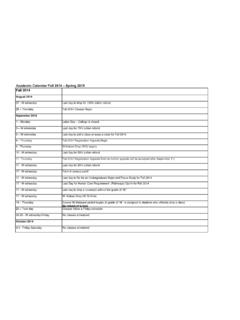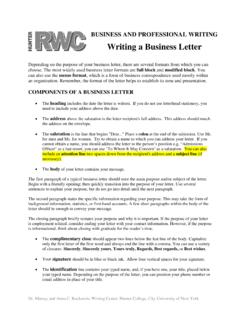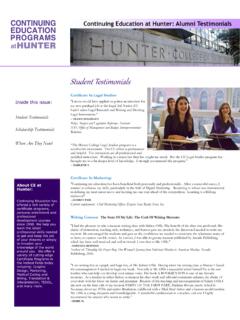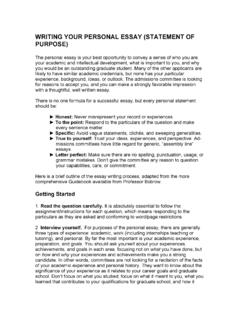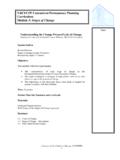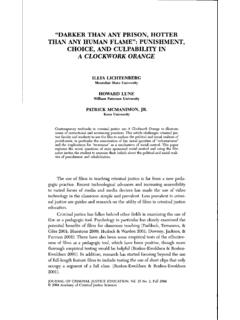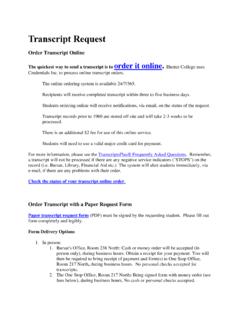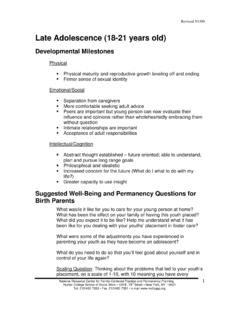Transcription of Interviewing Children 011708
1 Interviewing Children *. Excerpts from an article for Court Appointed Special Advocates to help professional evaluators interview Children Many of the techniques listed in this article can be used by child welfare workers to interview Children to assess the child's safety and well-being. This should not be confused with an ability to use these as therapy or to diagnosis a child. Document Author: Rosemary Vasquez, Contact: NCASAA Program Relations Staff Date Posted: April, 2000. Source: Choosing appropriate interview Questions It is difficult to do an entire interview without asking any questions. It is more effective to use open-ended, or indirect questions. Research shows that Children provide more accurate information when they are freely narrating, rather then when they are being asked direct questions (Garbarino). Open-ended questions allow Children to expand on their ideas and give us a better sense of their thinking.
2 Asking Children to describe their home, their parents, or what they enjoy doing, allows them the freedom to elaborate as they choose. Indirect questions provide a margin of safety for the child. If Children are asked questions such as, "Some kids believe all boys should live with their Dads, what do you think?" or "Why would it be a good idea if the judge decided_ ," then they have an opportunity to comment, without feeling that they are directly revealing their choice. As evaluators, we have to try to find indirect ways to help the child share important information. If a child avoids an issue, then it may be necessary to try another approach As an evaluator, you should encourage Children to ask questions, and ask them to share whatever they would like about themselves or their family. Children enjoy having a sense of control over what they will be doing and saying. Confidentiality Another issue to consider in Interviewing Children for an evaluation is confidentiality.
3 Gardner avoids this issue, but does ask the Children if there is anything they've said during the interview that they do not want their parents to know. Some courts have guidelines which state that Children are to be informed that the information they provide will not be confidential. Evaluators need to comply with their court, or if their court does not offer any guidance, reach a decision of their own. At the end of the interview you may want to ask the child if there is anything they do or do not want you to tell their parents or the judge. 1. Developmental Stages and Interviewing Techniques At the beginning of the interview , it is important for you to assess the child's developmental level and to frame the interview so that age- appropriate interview techniques are used. It is important not to confuse chronological age with normal developmental stages. A child's developmental age may not match what may be expected for the child's chronological age.
4 You need to integrate your knowledge of child development with your knowledge of the child's sense of time, temperament, and language abilities. Some of this information may be obtained through interviews with the parents, either through questionnaires completed by the parents, consultations with school teachers, or your own observations. Once you have a sense of the child, it becomes easier to understand the child's thinking. What the child says and does can best be interpreted by understanding the child's developing cognitive abilities and emotional state of mind. When formulating questions to ask a child, it is important that the questions be appropriate for the developmental level of the child. The following developmental stages address some of the developmental considerations which can be useful in planning an interview with a child The interview Setting A home visit allows you an opportunity to enter that particular child's world and learn about the child's home and play environment.
5 When doing a home visit, I always take certain items which I may want to use in the interview . The items depend on the age of the child and on the information I am trying to elicit. I always include drawing paper (large and small), felt pens, crayons, puppets, games, and a deck of cards. After the initial greetings with the family, I ask the child to show me the child's bedroom and play area and then proceed with the interview in a room which is separate from the rest of the family. Before leaving the home, I observe the child with the family and engage them in some interactive family activity. Beginning the interview During the initial part of the interview , you need to focus on helping the child feel comfortable and relaxed, and explain to the child why the interview is taking place. Initially, I let the child explore and move towards getting the child to share something about the child's self. I then share with the child my role in the process using drawings or the dry-erase board.
6 I use the latter to depict my meeting with the child's parents and to explain the importance of getting to know the child since I am trying to help the parents plan for the necessary changes in their lives I encourage the child to ask me any questions. As a way of reducing anxiety and engaging the child, I may introduce the "squiggle game, " ask the child to "draw yourself; " play a game of hangman (latency- 2. aged Children ), or do the card toss. Squiggle game. This game was introduced by Winnicott. In this game, the child and therapist each take a turn making a "squiggle" on a blank sheet of paper. A. squiggle is a continuous line drawn in circles or any other shapes. The child creates a drawing from the squiggle and describes what they've drawn. Some Children will color in each shape and others will make the shape look like some animal. Squiggles can become suggestive and express hidden conflicts when done repeatedly in a therapeutic situation.
7 I use it as a safe, nonthreatening way to engage Children of many ages. Winnicott describes squiggles as a way to loosen a child's defenses and to begin communication with the child. Draw yourself. I use this task to provide an indicator of the child's developmental level and to get a sense of the child's perception of self. After the child completes the drawing, I ask the child to give me some words that tell me what this child is like, thinking, or feeling. If this is a young child, I write the words on the child's picture or, if the child is older, ask the child to write the words which gives me an idea of writing and spelling skills. Hangman. Most Children eight and older know how to play hangman. I usually use a dry erase board and ask the child to draw a hanging platform and pick a word for me to guess. If the child seems very relaxed during the interview , I will ask the child to pick a word that will tell me how the child feels about being in this interview , how the child feels about the parents not living together, and/or about the parents fighting.
8 If the child is not sure how to spell the word, I get someone to write it on a piece of paper for them. The child then draws blank lines to represent each letter of the word below the hanging platform. I. begin guessing letters, and if they are not part of the word, the child writes the letters down along the side of the board and begins to "hang me" by putting a part of the body on the noose for each letter that is guessed incorrectly. If I guess the correct letter, it is written on the appropriate blank line. The objective is for me to either guess all of the correct letters or guess the word. If I have not guessed the word by the time an entire body is drawn, then I'm "hung," and the child reveals the word and wins the game. Card toss. I use an empty wastebasket and set it on the far side of the room. I take a deck of cards and the child and I take turns tossing a card into the basket, and keep score as to how many are successfully tossed in.
9 If it is a small child, I make sure the child is standing 3. closer to the basket than I am. This also works well when I am meeting the siblings together, because it provides a good opportunity to observe sibling interaction. Age appropriate Interviewing Techniques and Games When Interviewing Children , it is important to remember that what we observe may raise questions about the child and the child's life, but we must be cautious not to misinterpret their play or take their words literally. We do not want to reach a conclusion based on any one piece of information; it is best to use play to assist in formulating a hypothesis which can then be further explored. Information that emerges in play needs to be corroborated by other sources, such as further observation of the child during play techniques, teacher consults, or parental, sibling, and other relative interviews. Observe the affective tone of the play and the context in which the affect occurs.
10 Infants Since we cannot " interview " infants, I propose the following process. Direct observation of the child. Watch the child while playing, or generally relating to the parent, in order to gain a sense of the child's temperament. Observe the infant's development, and view the infant's reactions to a stranger (the evaluator). It may be useful to use the Baley's Infant Development Scale in assessing the developmental range. Note whether or not the baby makes eye contact (some are gaze avoidant). Ask yourself: What is this baby's affect? Is the baby dour? Does the baby show apathy? Does the baby seem comfortable with the parent? Is this a baby with- whom anyone could be happy? Assessing the parent-child interaction. It is important to note how the parent relates to the child. Note whether the parent appears to be calm, gentle, relaxed, and confident about parenting, or if the parent is anxious, easily frustrated, inattentive, indifferent, or detached.

